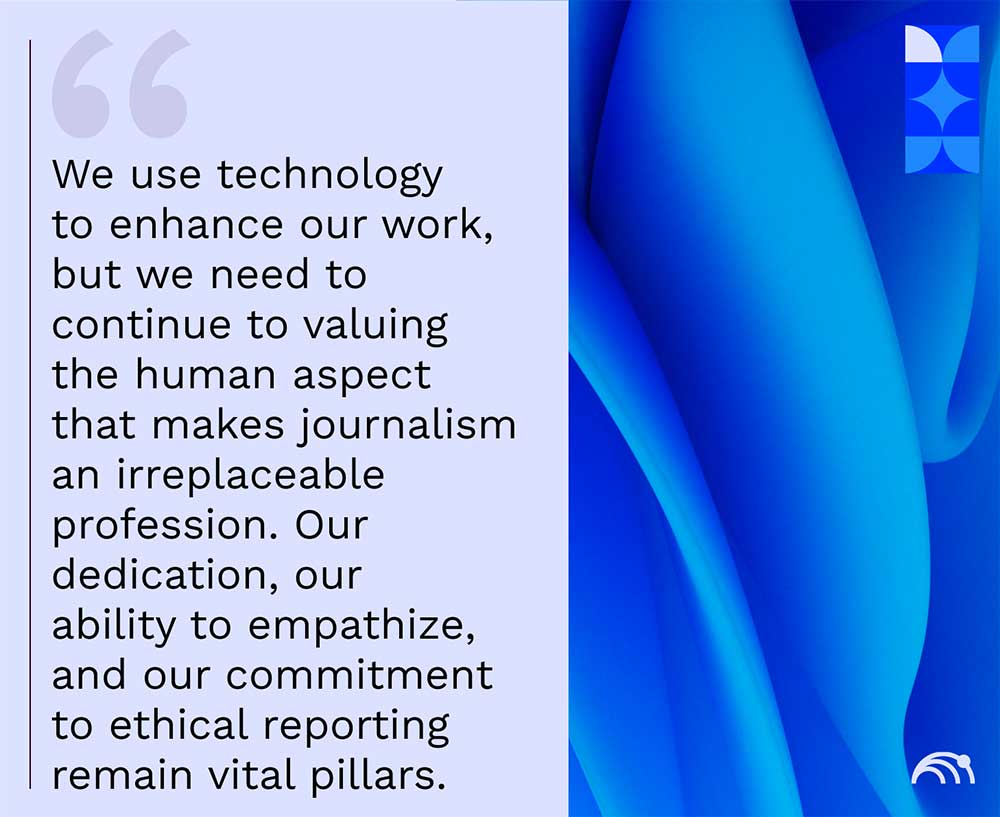How machines are revolutionizing the production and distribution of information. Balancing automation and human intervention to ensure quality and transparency, in an interview with Francesco Oggiano.
Artificial Intelligence has already changed the way we consume news, and it is also transforming the way we produce them.
While technology offers new and incredible opportunities, it is essential to keep in mind issues of ethics, transparency, and the protection of rights.
It is always difficult to predict the effects of ongoing changes. However, humans must always remain at the center of information.
Today we’re surfing with Francesco Oggiano, Journalist and Content Creator.
How is Artificial Intelligence influencing the production, distribution, and consumption of information?
In production, AI plays a crucial role by automating tasks such as assembly, photo editing, and proofreading. Also, it handles simpler journalistic tasks like generating short news pieces. Moreover, AI tools help journalists identify trends and potential story ideas.
For distribution, the first step usually is language translation. However, I expect that new AI tools will enable more advanced forms of translation, such as cultural translation. This would allow each article to be automatically adapted to the reader’s cultural context and understanding of the subject matter.
When it comes to consumption, today, much of the content we engage with is curated by increasingly sophisticated algorithms that understand and anticipate our preferences and needs. The major change we will see is the shift from choosing from options presented to us to deciding exactly what we want. When we decide, we have full control over our consumption choices. In contrast, when we choose, we are merely the final link in an upstream process over which we have limited control.
Have you used AI tools to enhance your work? What were the most significant outcomes?
There’s a saying I love: “When we truly embrace it, we stop calling it AI.” Reflecting on my daily life, I realized I’ve been using AI tools for years without even noticing, which is a testament to their seamless integration and efficiency.
From Echobox for social media posts, Premiere and other video-editing programs for repetitive tasks like automatic reframing and silence trimming, to Photoshop for photo editing, the entire Canva suite, Spark for automated emails, and Chrome extensions for automatic video summaries, AI is woven into my routine.
Over the past year, I’ve dedicated myself to daily experimentation with tools like ChatGPT, Gemini, and Claude, aiming for at least 20 minutes a day (though not always successfully). I use them for researching articles, brainstorming ideas and titles, and drafting outlines for more complex projects.
How can we balance the use of Artificial Intelligence for task automation with the need to maintain a creative and human approach in our work?
Consider Hairpin. Once a brilliant site dedicated to societal insights, it closed in 2018.
The domain was later acquired by a Serbian DJ who revived the site, filling it with AI-generated articles and transforming it into a low-quality, clickbait content mill: “What It Means When You Remember Your Dreams,” “8 Tips for Venting to Your Friends,” “What Is Holiday Blues.”
These pieces are authored by generic male names that don’t belong to real people. This trend is indicative of a larger phenomenon we’ll increasingly witness: quality websites being resurrected as click farms, a future where 90% of the web’s content will be AI-generated.
AI is already among us. We have two ways to utilize it. The first is the outdated method exemplified here, which will lead to the demise of journalism. The error we risk with AI is the same one we made in the 2010s. When digital technology infiltrated newsrooms, we turned newspapers into URL factories: a barrage of articles often written carelessly or using clickbait tactics to capture new audiences in the vast ocean of the internet.
Previously, underpaid journalists were exploited; today, it’s machines. The second way is to harness AI for deeper, more personalized, and international information. To use it to enhance what we already do, or even better, to achieve things we haven’t yet imagined.
The dedication of major tech players like Google and Microsoft to generative AI has spurred significant investments in the sector. With impressive technological developments, machines can write articles on specific topics, provide detailed information, create social media posts, write scripts for podcasts, and, with the more advanced capabilities of conversational models, adapt the tone and style of the texts.
However, the use of AI in journalism does not guarantee the complete absence of errors or the production of high-quality content. These are tools in the hands of people who decide how and where to use them. Therefore, we cannot entrust them with total responsibility, and the journalist will always remain the central figure in validating news.
We must remember that automation cannot replace human intuition and empathy. Our ability to understand context, listen to people, and tell their stories with sensitivity and depth is something that machines cannot replicate, or at least not with the same human efficiency. For this reason, AI should be seen as a support rather than a substitute.

What impacts and conditions arise from AI? How do you address such issues in your work?
We are in an epochal challenge for journalists and information professionals: combining innovation and professionalism while maintaining a strong bond of trust with the audience.
The application of AI tools offers an incredible array of opportunities to increase productivity, but it also raises concerns about the sources and accuracy of the information, which can lead to an increase in the overall rate of disinformation. This means clearly explaining how data are collected, how they are used, and what criteria underpin automated decisions.
I believe the most effective approach lies in the self-regulation codes being adopted by various outlets like Wired USA and AP. These codes are based on a very simple principle: everything that emerges from a newsroom is the responsibility of the journalist. According to the Head of AI Initiatives at the New York Times, the best content of the future will always involve humans overseeing journalistic processes, with AI playing a supportive role in the middle stages.
One of the topics dearest to you is that of fake news and half-truths and, in this regard, with the spread of AI they will lead to increasingly polarizing discussions. What challenges will emerge?
In my opinion, today, the greatest danger is not regarding fake news, or not only (I have a considerable faith in newsrooms’ efforts to uncover and debunk them), but rather the polarization fostered by AI-generated content.
The New York Times conducted a fascinating experiment where they created two almost identical chatbots, with only some light differences: one had a subtle liberal bias, the other a subtle republican bias. When they asked questions about the upcoming American presidential elections in November, the chatbots’ responses were strikingly different and, at times, quite “toxic”, reflecting their political leanings. I believe one of our most crucial tasks ahead is to program chatbots to minimize biases and partiality as much as possible.
The main issue concerns the potential lack of transparency in the use of generative AI, and not everyone has strategies in place to address these challenges.
The UE, by approving the “AI Act”, has been quick to legislate on the use of technology, paving the way for discussions on the issues related to unregulated use. Regarding generative AI, it has made it mandatory to disclose the training models used.
What opportunities emerge from integrating AI into journalism? What additional skills do you think are needed to take full advantage of these technologies?
The world of journalism has always been highly interdisciplinary, and our North Star has always been the pursuit of truth.
Today, society continuously and rapidly produces vast amounts of data that must be analyzed. Thanks to technological advancements, for example, we can read millions of documents in a very short time by inputting them into a database, measure the level of deforestation in a country using satellite images, and remotely control an entire smart home with connected devices.
Why shouldn’t benefits of this caliber also arise in the journalistic context?
Thanks to the introduction of AI-based tools, we can not only pursue the truth but also tell it with scientific rigor using new research criteria. Digital data allows us to monitor new contexts we hadn’t even considered before, and with machine learning, we can retrieve this data at unimaginable speeds.This does not mean that journalism will become a mere exercise in big data analysis.
The responsibility and transparency of the journalist using these tools will be essential to ensure a high standard of journalism.
I believe that since AI is a technology destined to stay, it will become increasingly easy to manage and interact with. That’s its job, after all!
I think that rather than technical skills (hard skills), we will need more soft skills such as curiosity, open-mindedness, creativity, and the willingness to experiment with new approaches and innovations.
Again, it won’t suffice to ask how we can make AI replicate what we already do in our newsrooms. We must ask how we can leverage AI to achieve what we have never done before.
Continuous training and skills development are essential. We must be prepared to work with these new technologies, understanding their limits and potential. Only in this way can we make the most of AI without losing sight of our unique role as storytellers and guardians of the truth.
What are your predictions for how AI will impact your work in the coming years? What new applications and changes might we expect in the industry?
I’m not entirely sure. The relationship between AI and journalism is set to evolve significantly in the coming years, bringing a series of changes and new applications that will transform how news is gathered, analyzed, and distributed.
Advanced algorithms can scour vast volumes of online data, from social media to public documents, identifying trends and emerging news that might otherwise go unnoticed. This ability to analyze large-scale data could allow us to identify important stories and act swiftly.
AI will play an increasingly important role in personalizing the user experience. AI-based recommendation systems can suggest articles and videos tailored to users’ interests and reading behaviors, enhancing engagement and audience satisfaction. However, there is a risk of creating “filter bubbles,” where users are exposed only to content that reinforces their existing beliefs. Therefore, it will be crucial to find a balance between personalization and diversification of information.
The change is underway and cannot be stopped. Legitimate ethical concerns that arise can be mitigated by regulations on transparency and human oversight of outputs.
Overall, I believe and hope to further reduce the time spent on tasks that can be delegated, increase the distribution of my content, and most importantly, create new products that have never been conceived before.
The first step in this direction is to create my own small AI version. This AI, fueled by my writings and a five-year archive of my newsletter, will be able to answer specific user questions in my unique writing style. This will be my first small experiment in creating a product using AI.
Originally from Puglia and now based in Milan, Francesco Oggiano is an alumnus of the IULM – Mediaset journalism school. In 2019, he embarked on a freelance career, contributing to notable publications such as Vanity Fair, Il Fatto Quotidiano, Wired, Il Foglio, and Donna Moderna. Since January 2020, he has served as the lead creator at the digital news startup WILL, hosting a number of successful podcasts. He also teaches media at Chora Academy and authors the “Digital Journalism” newsletter, which reaches an audience of over 20,000 subscribers.
